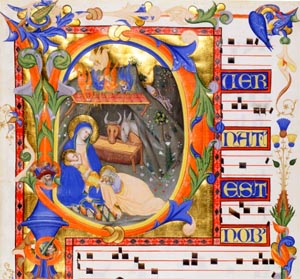“All
Ye Hevinly Operations”
– An Advent Anthem on Christ's
Coming
.
.
by Stephen Bick
I
was walking around my neighborhood this late
autumn morning, talking with my mentor, as I
do every other week, and on several
occasions we both had to interrupt the other
and point out a particularly lovely garden
or fiery tree so that we wouldn’t pass them
by unnoticed. We apologised for the
interruption each time, but understood that,
while our conversation was important, it
would almost be a rejection of the goodness
of creation not to alert the other to the
wonders around us.
The trees were doing their own kind of
pointing, anyway. The colors are costly: the
plants expend vast amounts of energy turning
the leaves red and yellow and brown, just
when they ought to be saving it for the
winter. Nobody knows why this happens, but
as Advent approaches I wonder whether there
isn’t a certain prophetic edge to the
scarlet and gold at this time of year,
almost as if they’re trying to join us in
heralding Christ as we prepare to celebrate
his first coming, and look to his second.
From poem to
musical piece
The same impulse is behind William Dunbar’s
poem, On the Nativity of Christ,
which I set to music a few years ago. Dunbar
was one of the most famous of the makar, a
group of court poets in 15th- and
16th-century Scotland. Not content to
announce the Incarnation to his immediate
neighbors, he summons the entire mediaeval
world - not only men and women, animals and
plants, but the four elements and several
ranks of angels - to worship Christ Jesus,
born for us at Christmas.
Characteristically, Dunbar includes
references to Latin hymns, which would have
been familiar to his audience as the texts
of various chants for Catholic liturgies at
Advent (Rorate caeli desuper, ‘drop down, ye
heavens, from above’, on the first Sunday of
Advent) and Christmas (Pro nobis puer natus
est, ‘for us a son is born’, on Christmas
morning [as seen in the illustration at the
top of the page]).
This
is all supposed to be more of a roll
call than an encyclopedia, but as I
wrote my piece I saw the opportunity
to try something similar and show as
many elements of Dunbar’s musical
world as possible. I included
fragments of plainchant alongside
elements from modern-day Scottish
folk music, to try and make the
experience of hearing my piece
something like a three-minute trip
to medieval Scotland and back. The
title of my piece comes from one of
the lines of the poem: after the
angels, Dunbar summons some
celestial bodies for good measure:
‘all ye hevinly operations: star,
planeit, firmament and spheir’ (the
original spelling).
In his day-job as Professor of
Medieval and Rennaisance Literature,
CS Lewis said of this poem that
it "might almost claim to be
in one sense the most lyrical of all
English poems - that is, the hardest
not to sing." That’s certainly been
my experience, and I hope yours,
too, as you listen to my piece.
> Click
red button below to hear audio clip
|
On
the Nativity of
Christ
poem
by Wiliam Dunbar
Rorate, caeli, desuper!
Heavens, release
your balmy showers,
For now is risen the
bright day-star,
From the rose Mary,
flower of flowers;
The clear Sun, whom
no cloud devours,
Surpassing Phebus in
the East,
Is coming from his
heavenly towers,
Et nobis Puer
natus est.
Archangels, angels, and
dominations,
Thrones, potentates,
and martyrs various,
And all ye heavenly
operations,
Star, planet,
firmament, and sphere,
Fire, earth, air,
and water clear,
To Him give loving,
most and least,
That comes in so
meek [a] manner
Et nobis Puer
natus est.
...
Sing, heaven imperial, most of
hight,
Regions of air, make
harmony.
All fish in flood
and fowl of flight,
Be mirthful and make
melody.
All “Gloria in
excelsis” cry,
Heaven, earth, sea,
man, bird, and beast:
He that is crowned
above the sky
Pro nobis Puer
natus est. |
Stephen Bick grew up in
the Antioch community in London. After a
gap year in Lansing and musical studies in
Cambridge, he has now inevitably returned
and lives with the Servants of the Word as
an affiliate. He works for the local
university outreach, Koinonia and divides
the rest of his time between professional
singing and composition and
semi-professional gardening.
manuscript illustration (top) by Don
Silvestro dei Gherarducci's Nativity in an
Initial P (Morgan Library, c. 1392-1399)
|

